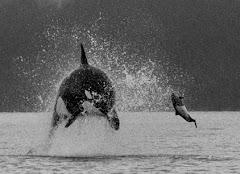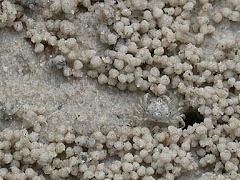Thursday and Friday we discussed fishing and seafood harvesting, the good, the bad, and the just plain ugly.
The truth is that our oceans are being fished to extinction and emptiness. We are harvesting more and more fish from smaller and smaller populations. What is a person to do that wants to eat seafood, but not hurt the environment?
 BECOME AWARE
BECOME AWARE. Most people do not know where their seafood came from or how it was caught.
How it was caught makes a big difference. Different fishing methods have pros and cons for the environment and regarding bycatch (fish and other organisms like sharks, sea turtles, sea birds, and dolphins, that are caught, often killed, and not really wanted).
One of the biggest things to avoid is any kind of imported shrimp. Imported shrimp are either caught with destructive trawl nets that destroy habitats and that do not have TEDs that allow turtles and dolphins to escape unharmed or they are farmed in aquaculture plants that are built on destroyed mangrove forests that then leach pollution and kill nearby coral reefs.
The United States requires all shrimp trawlers to be outfitted with TEDs and regulates where they can trawl. The US has higher standards for pollution laws and laws protecting shore habitats that result in less damage to the environment.
Choose US shrimp ONLY!If you would like more information - check out
SeafoodWatch, a non-profit organization that independently evaluates fisheries for their sustainability and environmental impacts.
This article also has some really nice information and photos.
Sustainable seafood.
 Today we learned about shark senses. Sharks have a large brain to help process the sensory overload they must get from the SEVEN senses they have. They have the five we have plus a lateral line (pressure and vibrations) and the ampullae of lorenzini (electro-reception).
Today we learned about shark senses. Sharks have a large brain to help process the sensory overload they must get from the SEVEN senses they have. They have the five we have plus a lateral line (pressure and vibrations) and the ampullae of lorenzini (electro-reception).


 Fish reproduce in a variety of ways. Most are broadcast spawners, meaning that when the time is right, the females release their eggs, the males release their sperm and they both meet and mix producing fertilized eggs that develop into fish fry and eventually into adult fish. These snapper are spawning and you can tell by the large cloud of gametes in the water.
Fish reproduce in a variety of ways. Most are broadcast spawners, meaning that when the time is right, the females release their eggs, the males release their sperm and they both meet and mix producing fertilized eggs that develop into fish fry and eventually into adult fish. These snapper are spawning and you can tell by the large cloud of gametes in the water.


